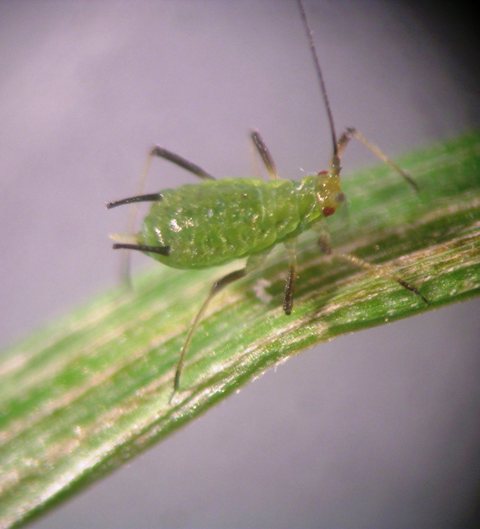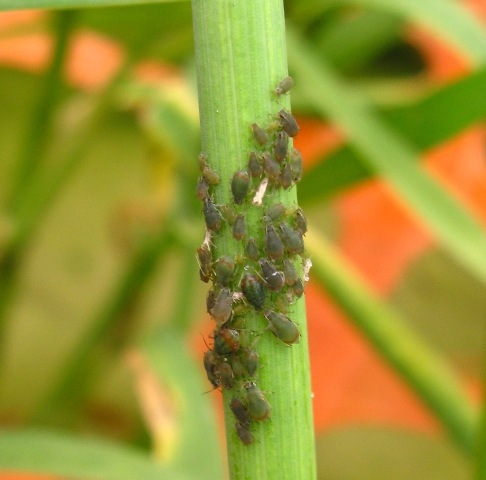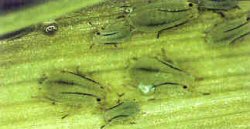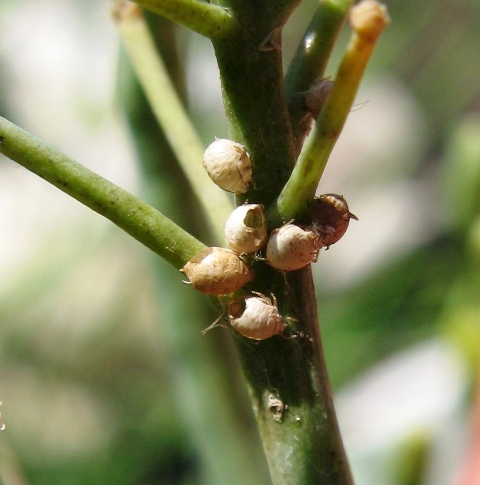Aphids On Cereals
Host Crops
Small grain cereals (wheat, oats, barley, rye).
Most abundant species
In Manitoba, the English grain aphid (Sitobion avenae) and the oat-birdcherry aphid (Rhopalosiphum padi) can commonly be found on cereal grains, and the greenbug (Schizaphis graminum) occurs sporadically. The corn leaf aphid (Rhopalosiphum maidis) may at times be present on corn or small grain cereals. Other less numerous species of aphids are also found on cereals in Manitoba. The term cereal aphid is sometimes used as a generic term to describe the complex of aphids commonly found on cereal crops.
Identification of Common Species


Figure 1. English grain aphid. Figure 2. Oat-birdcherry aphid.
| English grain aphid | Oat-birdcherry aphid |
|---|---|
|
|
|
|
|
|

| Greenbug | |
|---|---|
|
|
|
|
|
Feeding behaviour
English grain aphids can often be found on the heads, feeding on the ripening kernels of cereal crops. When sufficiently large populations develop, their feeding shrivels the growing kernels.
On wheat, the oat-birdcherry aphid prefers the stems and lower leaves, whereas the English grain aphid is found mostly on the head and upper leaves of the plant. The oat-birdcherry aphid is the main vector of barley yellow drawf virus on the prairies. English grain aphids can also vector barley yellow dwarf virus, but are not as efficient a vector as the oat-birdcherry aphid.
The greenbug has a saliva which is toxic to the plant and causes discoloration and brown spotting on the leaves it is feeding on.
Aphids also produce large amounts of honeydew that can promote the growth of saprophytic and pathogenic fungi on the plant.
Research on aphids in spring wheat showed that aphids caused more damage when they feed on younger plants than more mature plants, and that greenbugs and oat-birdcherry aphid were more damaging than English grain aphid at similar population densities. Research on English grain aphid feeding on winter wheat found that there was a greater yield reduction for a given aphid density when plants were grown under severe water stress than nonstress conditions.
Scouting Techniques
Monitor from June until the soft-dough stage in small grain cereals. Check 20 stems in each of five areas. Counts should be at least 50 paces apart, and observations should be made well into the center of the field. Too frequently farmers become alarmed after checking a few plants along the margins, especially near shelterbelts, where populations are high. Record the total number of aphids and calculate the average per stem.
Look for symptoms of damage, including leaf discolouration in host plants. Severe infestation may appear as large, bronzy or brown patches in the field, often visible from the road. Later in the season, these patches may appear as thin stands.
Agronomists routinely take stem samples for aphid counts. Cut the stem close to the ground and then hit it sharply against a stiff piece of white paper or into a white pan. This dislodges the aphids so they can be counted.
When counting aphids, note the presence or absence of predators, parasitized aphid mummies, or aphids killed by fungi.

Figure 4. Aphid "mummies" - swollen, dead aphids that have been tanned and hardened due to parasites. Note the holes where the parasites emerged from some of the aphids.
Economic Thresholds
The economic threshold for aphids on cereals is an average of 12 to 15 aphids per stem prior to the soft dough stage. After the early dough stage insecticide treatments would not be cost-effective.
Control Tips
Planting date: Early seeded crops may develop past the susceptible stage before aphid populations reach damaging levels. Early planted spring cereals may be at less risk of damage from barley yellow dwarf than cereals planted later.
Biological controls: Natural predators (such as lady beetles, hover fly larvae and lacewings) and parasites usually keep populations of aphids under control. For more information on predators and parasitoids of crop feeding insects, see the factsheet http://www.gov.mb.ca/agriculture/crops/insects/pubs/predatorsofinsectsfactsheet.pdf
Rain and wind may decrease populations of aphids on cereal crops.
Insecticides: Malathion and dimethoate (Cygon) are registered for the control of aphids in small grain cereals in Canada. Both of these are insecticide options are quite general in the spectrum of insects they control and would also kill many of the natural enemies of aphids.
If natural enemy populations are sufficiently high they can keep a population of aphids below the economic threshold and may result in the population of aphids declining rather than increasing.
Before deciding to apply insecticides for aphids, consider:
- the aphid population (is it near or above the economic threshold),
- the stage of the crop,
- evidence of natural enemies (predators, parasitoids, and pathogens),
- the pathogen vectoring potential of the species of aphid,
- are any heavy rain events forecast for the near future,
- and additional stresses (such as drought) that the crop may be under.

